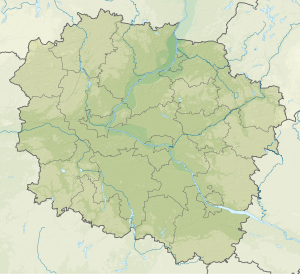Wenecja castle ruins
| Wenecja castle ruins | ||
|---|---|---|
|
overall view |
||
| Creation time : | circa 1375 | |
| Conservation status: | ruin | |
| Place: | Żnin | |
| Geographical location | 52 ° 47 '51.1 " N , 17 ° 44' 59.3" E | |
| Height: | 80 m npm | |
|
|
||
The castle ruins in Wenecja and the village of the same name (German name: Venetia ) belong to the urban and rural municipality Żnin , thus to the district of Żniński and the Polish Kujawy-Pomeranian Voivodeship .
history
The castle was built in the course of the border security of the kingdom by the last Polish Piastenkönig Casimir the Great in the second half of the 14th century in the then swampy area around the river Gąsawka (German: Gonsawka ) from nobles Mikołaj Nałęcz from Chomiąż built. Nałęcz supposedly bore the nickname “Devil of Wenecja” because he was a judge in the Kalisz province and in this capacity is said to have passed harsh sentences against the rural population. According to legend, he was punished by God for causing the walls of the Wenecja castle to collapse over him. The peasants he had thrown into his underground dungeons were also killed with him.
In fact, the castle didn't last long. As early as 1395 it was damaged for the first time in battles between the Wielkopolska tribes Nałęcze and Grzymała . After the builder's death around the turn of the century, it fell to his grandson Mikołaj Pomian, who passed the facility on to the Archdiocese of Gniezno in 1420 . Archbishop Mikołaj Trąba initially had it reinforced to protect against the Teutonic Order - the important gunsmith Grzegorz from Ossek supervised the expansion against artillery fire. The castle was later used as a prison for priests. The next owner, Archbishop Jacob von Sienna , dissolved the prison in 1461 and ordered the castle to be demolished, although part of it was still in use until 1511.
In the years 1467 to 1473 it was the official seat of the Wielkopolska General Starosten Piotr Nałęcz from Szamotuł .
In the 16th century it had already been partially demolished, and bricks obtained in the process were used to build the archbishop's palace. In the following centuries, the castle continued to deteriorate, until further parts were blown up in the 19th century and used as building material for the construction of the road to Żnin. Since then the castle has been in ruins.
Structure and location
The Gothic complex was built from stone and granite rock; upper parts were made of bricks. It had a square floor plan with a defensive tower on the northeast corner and the access gate in the central part of the south wing. Parts of the stone and brick walls that make the division of the interior recognizable have been preserved. In the “Archaeological Department” of the Jan Kasprowicz Museum in Inowrocław, there are finds that were recovered during the castle's excavation work.
The castle is surrounded by the Biskupińskie, Weneckie and Skrzynka Lakes. It belongs to the historical Pałuki region. There is also an open-air museum for narrow-gauge locomotives in Wenecja, right by the ruins . The reconstructed Iron Age wooden village of Biskupin is five kilometers to the south .
literature
- Information board in front of the ruin
Web links
References and comments
- ↑ according to Article Castle ruins in Wenecja (Venice) near Znin on the website of the City Council of nin (English)
- ↑ This is where clergymen who had joined Jan Hus's ideas about the Reformation were presumably imprisoned .
- ↑ according to Jerzy Sobczak: Pałuki . Krajowa Agencja Wydawnicza, Poznań 1987, ISBN 83-03-01818-3 (Polish).
- ↑ according to Article Znin, Wenecja, Biskupin at visitkujawsko-pomorskie.pl
- ↑ according to Article Jan-Kasprowicz-Museum ( page no longer available , search in web archives ) Info: The link was automatically marked as defective. Please check the link according to the instructions and then remove this notice. on the Inowrocław city website

